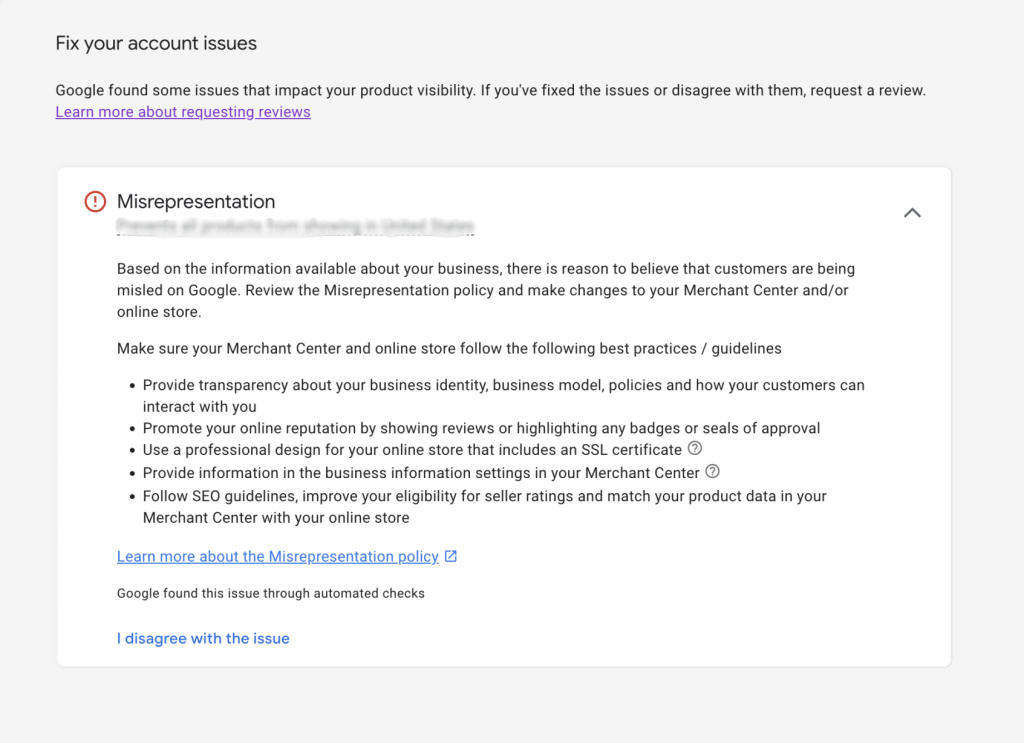The “Misrepresentation” account issue in Google Merchant Center is one of the most common and serious problems sellers face.
It typically means Google believes your store is not providing accurate, transparent, or trustworthy information. If left unresolved, this can result in product disapproval or account suspension.
Here are 5 common causes of Misrepresentation in Google Merchant Center and why they trigger this issue:
Inaccurate or Misleading Product Information
- Why it happens: Google requires that your product listings accurately reflect the product being sold. If there are inconsistencies between your website and product feed (e.g., incorrect prices, fake discounts, or misleading descriptions), it raises a red flag.
- Examples:
- Advertising a product as “free shipping” when the checkout process adds shipping fees.
- Displaying false promotions (e.g., claiming a “50% discount” when it’s the regular price).
- ✅ Fix: Ensure your product titles, descriptions, images, and pricing exactly match your website and avoid exaggerating features or benefits.
Bob’s Sandal Shack Example
Bob runs Bob’s Sandal Shack, a thriving online store specializing in quirky, high-quality sandals. To boost summer sales, Bob decided to launch a bold marketing campaign with the slogan:
👉 “BOGO 50% Off – Get Your Second Pair Half Price!”
Excited to drive traffic, Bob updated his Google Merchant Center product feed to reflect the promotion. However, in his rush, he made two critical mistakes:
🚨 What Went Wrong?
Inaccurate Pricing in the Product Feed:
Bob updated the product titles to say “BOGO 50% Off”, but the actual price in the feed still reflected the full price for each pair. Google flagged this as misleading because users expected a discount that wasn’t automatically applied.
Hidden Discount at Checkout:
The BOGO 50% Off promotion only applied if customers entered a promo code at checkout—but Bob never mentioned this in his ad or product listings. Customers felt deceived when they didn’t see the discount automatically applied.
📧 The Fallout:
Within a week, Bob received a dreaded “Misrepresentation Policy Violation” notice from Google Merchant Center, and his entire product catalog was disapproved—meaning no more sandal sales through Google Ads.
Worse, frustrated shoppers left negative reviews about the “bait-and-switch” pricing.
🔨 How Bob Fixed It:
Bob knew he had to act fast to restore his ad visibility. Here’s how he turned things around:
Updated Product Feed for Accuracy:
He revised all product titles and descriptions to remove misleading claims. Instead of “BOGO 50% Off,” he clearly stated:
✅ “Buy One, Get One 50% Off – Discount Applied at Checkout.”
Clarified Promotion Mechanics:
Bob added a banner on his website and a line in product descriptions explaining that the discount required a promo code—ensuring shoppers knew exactly how to claim the offer.
Resubmitted the Feed & Requested Review:
After correcting the discrepancies, Bob re-synced his product feed and submitted a request for account review through Google Merchant Center.
🎉 The Outcome:
Within 5 business days, Google reinstated Bob’s product listings. His BOGO promotion, now transparent and accurate, led to a 20% increase in sales—and no more policy violations.
Bob learned a valuable lesson: Accuracy and transparency aren’t just for Google—they’re the key to happy customers and long-term success.
Missing or Incomplete Business Information
- Why it happens: Google wants to ensure shoppers can trust your business. Missing or vague information on key policies (such as refunds, returns, shipping, or contact details) raises concerns about transparency.
- Examples:
- No visible refund or return policy on your website.
- A “Contact Us” page with only a form and no physical address, phone number, or email.
- ✅ Fix: Add clear and accessible pages for Shipping, Returns/Refunds, and Contact Information that match Google’s requirements.
Syd’s Sardine Emporium Example
Syd runs Syd’s Sardine Emporium, a beloved online shop specializing in gourmet sardines from around the world. His quirky branding and promise of “Sardines Shipped Straight to Your Door!” attracted a loyal following—until one day, disaster struck.
🚨 What Went Wrong?
Syd received a Misrepresentation Policy Violation notice from Google Merchant Center, causing all his sardine listings to be disapproved. The problem? Missing business information that made his store seem untrustworthy to Google.
Here’s where Syd slipped up:
No Refund Policy:
While Syd proudly guaranteed the “Freshest Tinned Fish Online,” he had no visible refund or return policy explaining what happens if a customer receives a damaged or expired product.
Vague Contact Page:
Syd’s Contact Us page only had a generic form—no email address, phone number, or physical location. To Google (and skeptical shoppers), it looked like Syd was hiding something.
Incomplete Shipping Information:
Syd promised “Worldwide Shipping” but never clarified shipping costs, processing times, or international delivery policies—leaving customers confused and Google concerned.
🔨 How Syd Fixed It:
Determined to get back to selling sardines, Syd took these steps to meet Google’s transparency requirements:
Created Clear Policy Pages:
Syd added dedicated pages with detailed, easy-to-find policies, including:
✅ Refund & Returns Policy: “If your sardines arrive damaged or past their ‘Best By’ date, we’ll issue a full refund or replacement—no questions asked!”
✅ Shipping Policy: Clear breakdowns of delivery times, costs, and regions served, including how he handles international orders.
Updated the Contact Page:
Syd made it easier for customers to reach him by adding:
📧 A dedicated customer service email: help@sardineemporium.com
📞 A business phone number for urgent inquiries.
📍 His warehouse address in case customers needed to return products.
Re-submitted the Merchant Center Review:
After updating his website, Syd logged into Google Merchant Center, confirmed the fixes, and requested a manual account review.
🎉 The Outcome:
Within 7 days, Google lifted the violation, and Syd’s sardines were back on the search results—just in time for his Annual Sardine Sampler Sale.
Thanks to the improved transparency, customer trust grew, and Syd even saw a 15% boost in sales, proving that clear policies = happy customers (and a happy Google!).
Using a Misleading or Inconsistent Business Identity
- Why it happens: Google verifies that your business identity is legitimate. If your business name, domain, or branding is inconsistent between your website and Merchant Center, it triggers a misrepresentation warning.
- Examples:
- Different business names on your website and in Google Merchant Center.
- Using a generic landing page without a recognizable brand identity.
- ✅ Fix: Ensure your business name, logo, and domain are consistent across Google Merchant Center, your website, and public business listings.
Selling Prohibited or Restricted Products
- Why it happens: Google has strict policies on what you can advertise. Selling prohibited items (like counterfeit goods, dangerous products, or unsupported supplements) or failing to provide necessary certifications can result in misrepresentation.
- Examples:
- Listing replica designer items as “authentic.”
- Selling age-restricted items without proper age verification measures.
- ✅ Fix: Review Google’s Prohibited & Restricted Content policy and remove or properly classify any restricted items.
Ned runs Ned’s Atomic Firecracker Factory, a quirky online store specializing in novelty fireworks for parties and celebrations. With his bold branding and explosive product range, business was booming—until one day, his Google Merchant Center account was suspended for Misrepresentation due to prohibited products.
🚨 What Went Wrong?
Ned’s enthusiasm for big booms led him to overlook some of Google’s Prohibited & Restricted Content policies. Here’s where he slipped up:
Selling Unapproved Fireworks:
While most of Ned’s inventory included harmless sparklers and poppers, he recently added “MegaBlast M-1000s”—a powerful firecracker that exceeded Google’s safety guidelines on explosive devices.
Incomplete Safety Information:
Ned failed to include essential safety warnings and age verification requirements on product pages. Some items required the buyer to be 18+, but his checkout process had no age check in place.
Vague Product Descriptions:
To make his listings sound exciting, Ned described his products as “industrial-strength” and “military-grade fireworks.” These terms raised red flags with Google, which prohibits the sale of dangerous or explosive materials.
🔨 How Ned Fixed It:
Determined to get his store back online, Ned took the following corrective actions:
Removed Prohibited Items:
He immediately deleted the MegaBlast M-1000s and other restricted items from his product feed and website.
Updated Product Descriptions:
Ned revised his listings to use accurate, non-exaggerated language. For example, “industrial-strength” became “premium-quality sparklers,” and he included clear safety guidelines on every product page.
Implemented Age Verification:
For any product requiring age restrictions, Ned integrated an age verification step at checkout, ensuring customers confirmed they were 18 or older before purchase.
Reviewed Google’s Policies Thoroughly:
Ned did a full audit using Google’s Prohibited & Restricted Content policy to verify that all remaining products complied with their guidelines.
Requested a Review:
After cleaning up his listings and processes, Ned submitted a manual review request through Google Merchant Center, explaining the corrections he made.
🎉 The Outcome:
Within 7 business days, Google lifted the suspension, and Ned’s Atomic Firecracker Factory was back in action—this time, with safe, policy-compliant products. With clearer descriptions and better compliance, Ned’s online store continued to light up the marketplace—without setting off any more Google alarms.
Poor Website or Checkout Experience
- Why it happens: Google expects a secure, user-friendly shopping experience. If your website is hard to navigate, lacks SSL security, or has a broken checkout process, it can trigger a misrepresentation flag.
- Examples:
- A checkout page that doesn’t load or doesn’t display full costs upfront.
- No secure connection (HTTPS) during checkout.
- ✅ Fix: Ensure your website is mobile-friendly, SSL-secured, and offers a smooth, transparent checkout process.
Bippy’s Pizza and Clam Chowder Hut—a bold fusion of New York pizza and New England clam chowder—was thriving. Bippy, the proud owner, decided to expand beyond his local fanbase by selling frozen pizza-chowder kits online through Google Merchant Center.
For a while, orders poured in—but one day, Bippy woke up to a dreaded Misrepresentation Suspension notice. His Google Merchant Center account was down, and no more orders were coming through.
🚨 What Went Wrong?
Despite Bippy’s delicious creations, his website experience left a bad taste in Google’s mouth. Here’s where things fell apart:
A Broken Checkout Page:
Customers trying to order Bippy’s famous “Clam ‘N’ Crust Combo” often couldn’t complete checkout—the page would freeze, and payments wouldn’t go through.
Hidden Shipping Costs:
Bippy advertised “Free Shipping” in his Google listings—but during checkout, customers were slapped with a surprise $14.99 “clam care” fee for insulated packaging. Google flagged this as misleading.
No SSL Security:
Bippy’s checkout wasn’t using HTTPS encryption, meaning customers’ payment info wasn’t fully protected—a major violation of Google’s secure shopping requirements.
🔨 How Bippy Fixed It:
Determined to get his pizza-chowder empire back on track, Bippy took these steps:
Fixed the Checkout Process:
Bippy hired a web developer to resolve the freezing issues on his checkout page, ensuring smooth transactions from cart to confirmation.
Made Costs Transparent:
He updated his product listings to clearly state:
✅ “Free Shipping on Orders Over $50 – $14.99 Packaging Fee Applies to All Orders”
Secured the Website:
Bippy installed an SSL certificate, ensuring every page—especially checkout—was secured with HTTPS encryption for safe transactions.
Improved User Experience:
He optimized the website to be mobile-friendly, making it easy for customers to order on the go.
Requested a Review:
Once everything was fixed, Bippy submitted a manual review request in Google Merchant Center, explaining the issues he addressed.
🎉 The Outcome:
Within 5 business days, Google lifted the suspension, and Bippy’s Pizza and Clam Chowder Hut was back in action—this time, with a smoother, safer checkout. With his online storefront back in Google’s good graces, Bippy was once again shipping his legendary fusion kits nationwide—no more checkout meltdowns or hidden clam fees!
💡 Pro Tip
Regularly audit your product feed and website to align with Google’s Shopping Policies. Addressing these five areas thoroughly increases your chances of maintaining a clean and compliant Google Merchant Center account.

